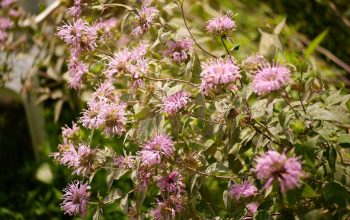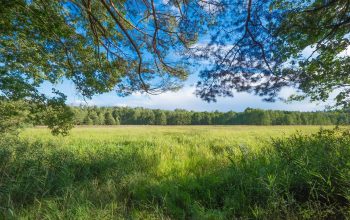Illinois is also known as the Prairie State, as nearly two-thirds of its territory is covered by tallgrass type of plant species. Even so, around 4.4 million acres are forested, mainly in the southern part of the state, which is roughly 12% of its total size. Around 250 different types of trees can be found, representing 29 families and distributed almost entirely in a couple of national forests. To date, about 30 invasive species have been reported, two insects of concern and one pathogen – Sudden Oak Death.
Most Common Tree Species
Oaks are the most predominating forest types of trees, while the most abundant in Illinois is Slippery Elm. Of around 90 Oak species in the United States, the Prairie State is home to 20 of them, as the White Oak was chosen for the state’s tree in 1973. Other common types are Shingle Oak, Swamp White Oak, and Red Oak. On the other hand, if we disregard the number, the Illinois forests contain a larger diversity of species – Maple, Birch, Hazelnut, Heath, Baldcypress, Pine, Magnolia, Willow, and dozens of others. Wild fruits can also be found, including Plum and Cherries.
According to the US Forest Service, the most widespread tree species across the state of Illinois are:
- Slippery Elm – statewide available, 60 to 70 ft tall, start flowering in February
- White Oak – forest type, 60 to 100 ft tall, flowering in May at leaves ready at one-third
- Chestnut Oak – mainly forest type, 60 to 70 ft tall, flowers start developing in April
- Red Maple – forest type, 60 to 70 ft tall, flowers in early spring
- River Birch – statewide, 40 to 70 ft tall, catkins appear in late summer
- Black Willow – pioneer forest type, 30 to 60 ft tall, flowers in Match to April
- Swamp White Oak – common in mixed forests, 50 to 60 ft tall, blooming period starts from the mid-spring.
White Oak – State Tree
As we already mentioned, White Oak was named Tree of State by Illinois residents in 1974. It’s the most common species among the state’s forests, standing up to 100 ft tall and has a maturity spread of up to 80 ft. It can be found in all Illinois counties as White Oak is drought tolerant and grows on almost any soil. Its diameter rarely exceeds 4 ft, but its crown is appreciated by many people for its solid shade. White Oak has yellow-green leaves going lighter on the tree’s downside.
Its timber has excellent qualities, and it’s widely used, including for the manufacturing of whiskey barrels. White Oaks are part of complex forest ecosystems, providing homes and food for many inhabitants. Squirrels and various birds eat its acorns, deers prefer the foliage, while beavers, rabbits, and many rodents feast on the twigs.
Slippery Elm – Most Abundant Tree
Slippery Elm is not just another Illinois native tree but the most common in number. It’s spread statewide and has low requirements in terms of soil and moisture. Slippery Elm can be found near streams and rivers, in bottomland and upland forests. The tree usually starts flowering at the end of February, and its leaves unfold in April. It can go up to 80 ft in height and 4 ft in diameter. The name of the tree comes from the slippery inner bark when chewed.
Slippery Elm is appreciated for its timber as well. The wood is strong and heavy, an ideal material for building boats and ships. In addition, it is widely used for manufacturing farming elements, fences, boxes, casks, and furniture. The Slippery Elm timber is an excellent raw material for papermaking. An interesting fact is that it’s the most abundant tree species across the Prairie State, but prairies are not its natural habitat.
National Forests and Park Areas
If you want to get yourself surrounded by White Oaks, Slippery Elms, and other native trees, visit one of the Illinois National Parks and forests. The state provides over 140 natural areas, offering unique flora and fauna. Here are some of the biggest and most popular state parks:
- Pere Marquette State Park
- Moraine Hills State Park
- Matthiessen State Park
- Starved Rock State Park
- Ferne Clyffe State Park
- Giant City State Park
- Shawnee National Forest
- Mississippi Palisades State Park
- Big River State Forest
- Sand Ridge State Forest.
Pere Marquette State Park is the biggest and one of the most scenic Illinois National Parks. It spreads across 8,000 acres and offers the best hiking, biking, camping, and boating conditions. It’s located near the city of Grafton, IL, on the beautiful Illinois River. If you love nature, Pere Marquette State Park, just like any other location on the list above, could be your paradise. Speaking about trees, these parks and forests are habitats for most state’s native species. If you are not much about camping, browse for some good offers for lodging and hotel accommodation around. Surely, you’ll find plenty of options!
Conclusion
Illinois has kept only around 19% of the forests on its territory but has also created hundreds of parks and protected areas. This effort has not been in vain, and today these places are home to many animals, birds, plants, and tree species. We can see oak-hickory ecosystems, ravines, swamps, and tallgrass prairies. Accommodation and amenities are available almost everywhere so that people can observe, feel, and appreciate this natural treasure. Moreover, given the climate change problems facing humanity today, the importance of protecting and preserving these tree species and forests becomes more and more vital for us all!




